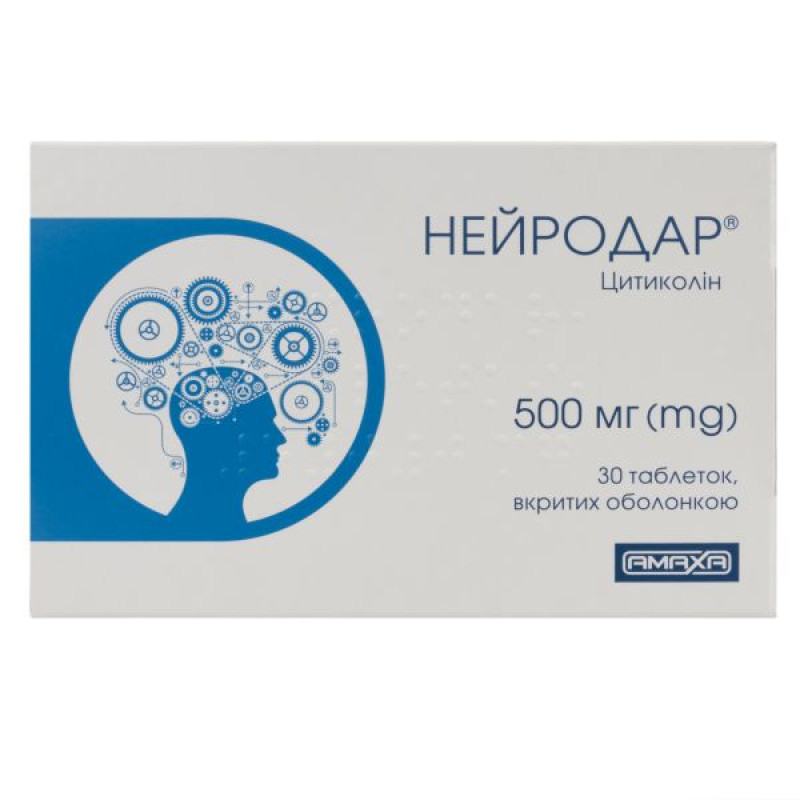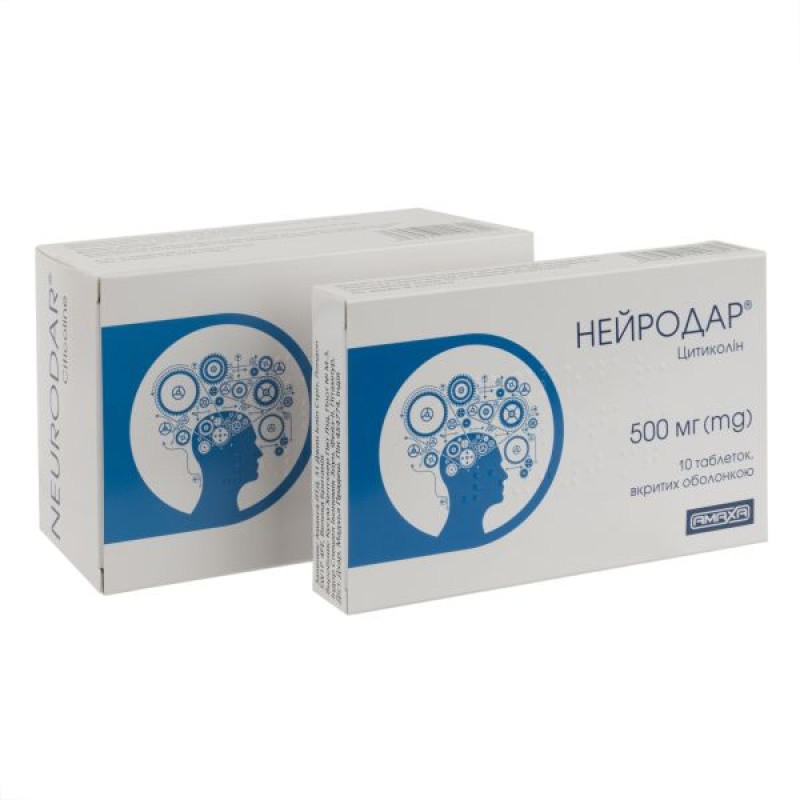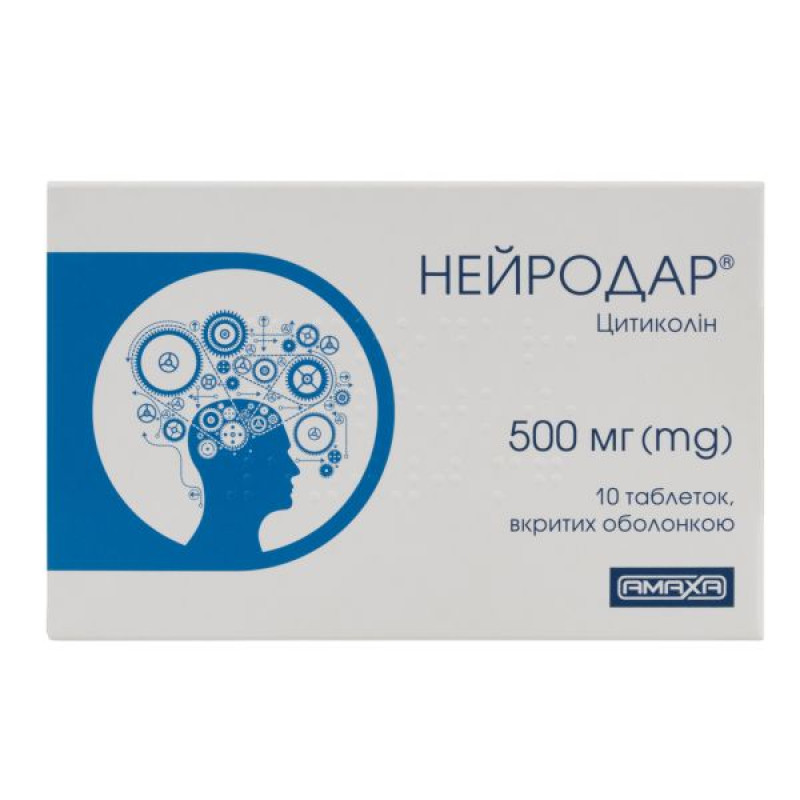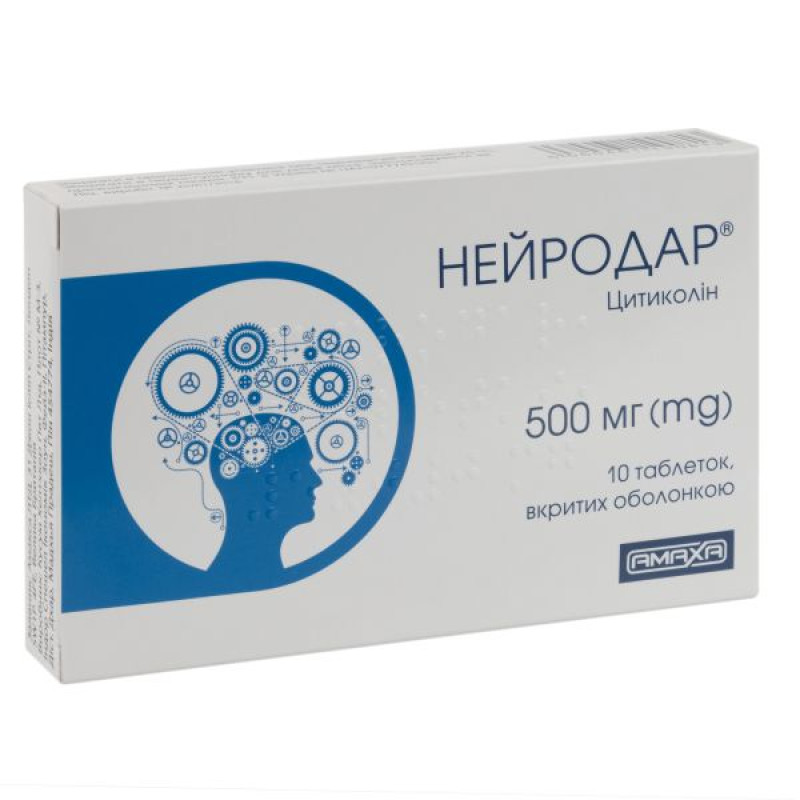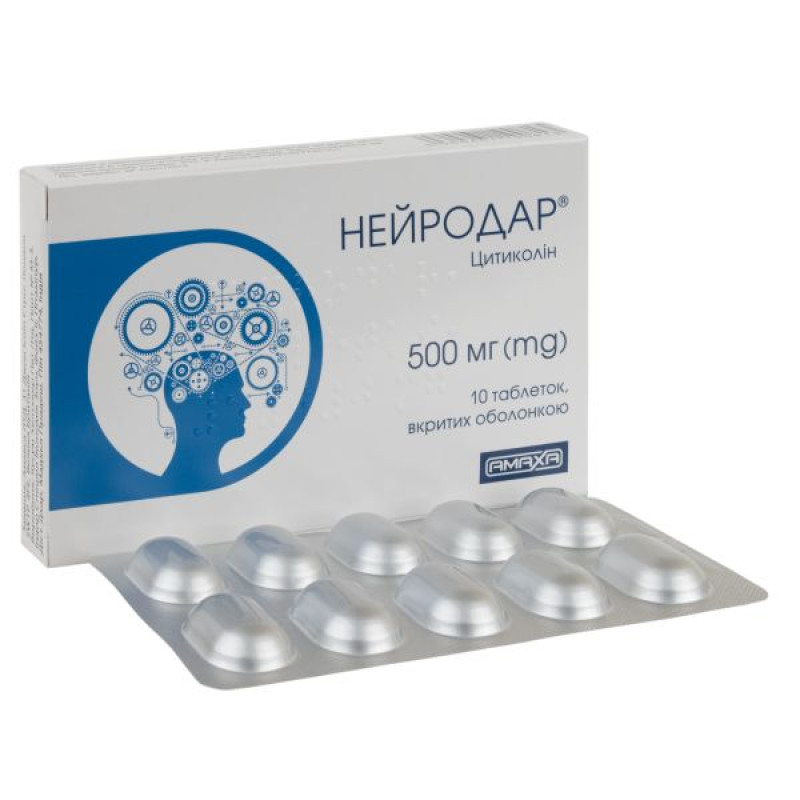Neurodar film-coated tablets 500 mg No. 30
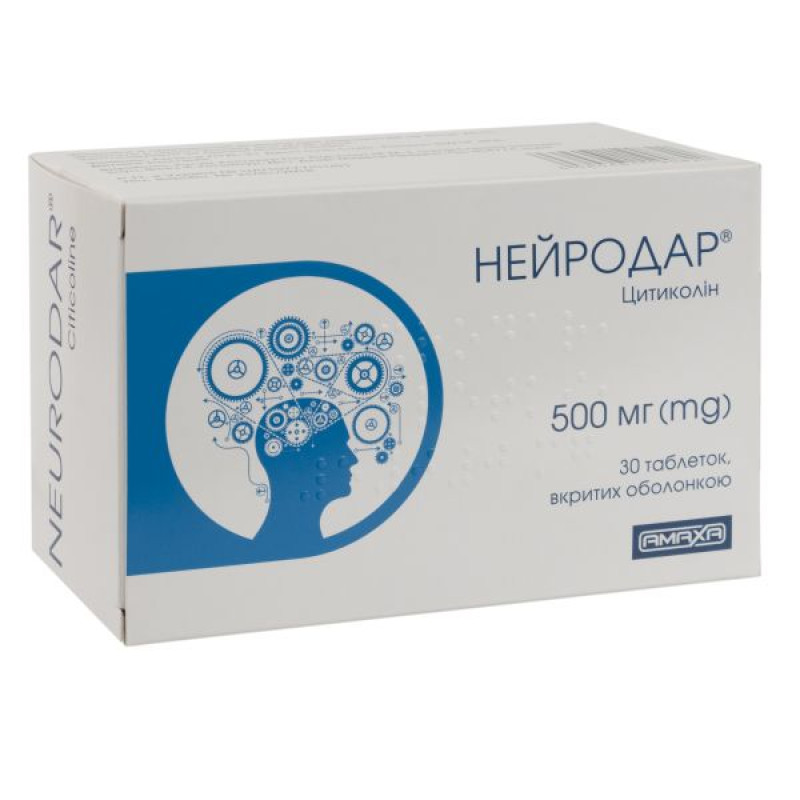
Instructions Neurodar film-coated tablets 500 mg No. 30
Composition
active ingredient: citicoline sodium;
1 film-coated tablet contains citicoline sodium equivalent to citicoline 500 mg;
Excipients: lactose monohydrate; microcrystalline cellulose; povidone; croscarmellose sodium; colloidal anhydrous silica; magnesium stearate; Opadry 03F58750 white coating.
Dosage form
Film-coated tablets.
Main physicochemical properties: smooth, capsule-shaped tablets, coated with a white shell.
Pharmacotherapeutic group
Psychostimulants, drugs used for attention deficit hyperactivity disorder (ADHD), and nootropics. ATC code N06B X06.
Pharmacological properties
Pharmacodynamics
Citicoline stimulates the biosynthesis of structural phospholipids of neuronal membranes, which is confirmed by magnetic resonance spectroscopy. Due to this mechanism of action, citicoline exhibits the functioning of such membrane mechanisms as the work of ion exchange pumps and receptors, the modulation of which is necessary for the normal conduction of nerve impulses. Due to its stabilizing effect on the neuronal membrane, citicoline exhibits anti-edematous properties that contribute to the reabsorption of brain edema.
Experimental studies have shown that citicoline inhibits the activation of certain phospholipases (A1, A2, C, and D), reducing the formation of free radicals, preventing the destruction of membrane systems, and preserving antioxidant defense systems such as glutathione.
Citicoline preserves the energy reserves of neurons, inhibits apoptosis, and stimulates the synthesis of acetylcholine.
It has been experimentally proven that citicoline also exhibits a preventive neuroprotective effect in focal cerebral ischemia.
Clinical studies have shown that citicoline significantly increases functional recovery rates in patients with acute ischemic stroke, which coincides with a slowdown in the growth of ischemic brain damage according to neuroimaging data.
In patients with traumatic brain injury, citicoline accelerates recovery and reduces the duration and intensity of post-traumatic syndrome.
Citicoline improves the level of attention and consciousness, cognitive and neurological disorders associated with cerebral ischemia, and helps reduce the manifestations of amnesia.
Pharmacokinetics
Citicoline is well absorbed after oral administration. After administration of the drug, a significant increase in plasma choline levels is observed. When administered orally, the drug is almost completely absorbed. Studies have shown that the bioavailability is almost the same after oral and intravenous administration.
The drug is metabolized in the intestines and liver to form choline and cytidine.
After administration, citicoline is widely distributed in brain structures with rapid incorporation of the choline fraction into structural phospholipids and the cytidine fraction into cytidine nucleotides and nucleic acids. In the brain, citicoline is incorporated into cellular, cytoplasmic and mitochondrial membranes, participating in the construction of the phospholipid fraction.
Only a small amount of the dose is found in the urine and feces (less than 3%). Approximately 12% of the dose is excreted through exhaled CO2. The process of drug excretion with urine occurs in two phases: the first phase – within 36 hours, in which the rate of excretion decreases rapidly, and the second phase – in which the rate of excretion decreases much more slowly. The same phasic nature is observed with excretion through the respiratory tract. The rate of CO2 excretion decreases rapidly – within about 15 hours, then decreases much more slowly.
Indication
- Stroke, acute phase of cerebrovascular accidents and their neurological consequences.
- Traumatic brain injury and its neurological consequences.
- Cognitive and behavioral disorders due to chronic vascular and degenerative cerebral disorders.
Contraindication
- Hypersensitivity to citicoline or to other components of the drug.
- Increased tone of the parasympathetic nervous system.
Interaction with other medicinal products and other types of interactions
Citicoline enhances the effect of levodopa. It should not be administered simultaneously with drugs containing meclofenoxate.
Application features
This medicine contains lactose. If you have been told by your doctor that you have an intolerance to some sugars, contact your doctor before taking this medicine.
This medicinal product contains no more than 26.806 mg/tablet of sodium. Caution should be exercised when used in patients on a controlled sodium diet.
Use during pregnancy or breastfeeding
There are no adequate data on the use of citicoline in pregnant women. Citicoline should not be used during pregnancy unless clearly necessary. During pregnancy, the drug should be prescribed only if the expected therapeutic benefit outweighs the potential risk. Data on the penetration of citicoline into breast milk and its effect on the fetus are unknown.
Ability to influence reaction speed when driving vehicles or other mechanisms
In individual cases, some adverse reactions from the central nervous system (CNS) may affect the ability to drive or operate complex machinery.
Method of administration and doses
The recommended dose is 500 to 2000 mg per day (1–4 tablets) depending on the severity of symptoms and the patient's condition.
The dosage of the drug and the duration of treatment are determined by the doctor.
Elderly patients do not require dose adjustment.
Children
Experience with the drug in children is limited, so the drug should only be prescribed when the expected benefit outweighs any potential risk.
Overdose
No cases of overdose have been noted.
Adverse reactions
From the psyche: hallucinations, agitation, insomnia.
From the nervous system: severe headache, dizziness, tremor.
From the cardiovascular system: arterial hypertension, arterial hypotension, tachycardia.
From the respiratory system: dyspnea.
On the part of the digestive tract: nausea, vomiting, stomach pain, hypersalivation, slight changes in liver function tests, episodic diarrhea.
On the part of the immune system: allergic reactions, including rash, itching, angioedema, anaphylactic shock, flushing, urticaria, exanthema, purpura.
General disorders: chills, fever, feeling hot, shivering, swelling.
Expiration date
3 years.
Storage conditions
Store in the original packaging at a temperature not exceeding 25 °C.
Keep out of reach of children.
Packaging
10 tablets in a blister; 1 blister in a cardboard box No. 10; 3 or 10 packs in a cardboard box No. 30 (10´3) or No. 100 (10´10).
Vacation category
According to the recipe.
Producer
Kusum Healthcare Pvt Ltd.
Location of the manufacturer and address of its place of business
SP-289 (A), RIICO Industrial area, Chopanki, Bhiwadi, Dist. Alwar (Rajasthan), India/SP-289 (A), RIICO Industrial area, Chopanki, Bhiwadi, Dist. Alwar (Rajasthan), India.
Plot No. M-3, Indore Special Economic Zone, Phase-II, Pithampur, Distt. Dhar, Madhya Pradesh, Pin 454774, India.
Applicant
Amaxa LTD/Amaxa LTD.
Applicant's location
31 John Islip Street, London SW1P 4FE, United Kingdom.
There are no reviews for this product.
There are no reviews for this product, be the first to leave your review.
No questions about this product, be the first and ask your question.










